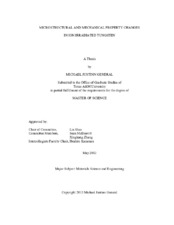| dc.description.abstract | Sustainable fusion power is within reach; however, more research is needed in the field of material science and engineering. One critical component of a fusion reactor is the plasma facing material. Very little literature exists on the sustainability of tungsten as a plasma facing material (PFM). During operation, PFM must withstand harsh conditions with combined effects from high temperature, mechanical stress, irradiation, transmutation, and the production of hydrogen (H) and helium (He) from nuclear reactions. Therefore, this thesis will focus on co-implantation of H and He into tungsten to investigate the mechanical and microstructural material response.
For the first part of this study, Molecular Dynamics (MD) was used to qualitatively understand defect migration and mechanical property changes in tungsten. A Brinell hardness test was simulated using MD in tungsten to study the dependence on void size and void density hardness. It was found that hardness changes vary as the square root of the void size and void density. Also the movement of dislocations and its interaction with voids were investigated.
For the second part of the study, H and He were co-implanted into tungsten to look at the mechanical and microstructural changes. Hardness changes were measured using a nano-indenter ex-situ on post-irradiated specimen. Results show that the hardness of tungsten after co-implantation is proportional to the square root of the fluence. Additionally, the microstructure of irradiated tungsten samples was investigated by using a Transmission Electron Microscope (TEM). It was observed that the defect microstructure in tungsten, after co-implantation, is quite complex, with a number of intriguing features, such as the presence of the nano-bubbles and dislocation loops. Also it was observed that there was an effect that H has on the nucleation of He nano-bubbles. The results from this work suggest that the effect of co-implanting H and He into tungsten is crucial to fully understand its viability as a PFM. | en |


